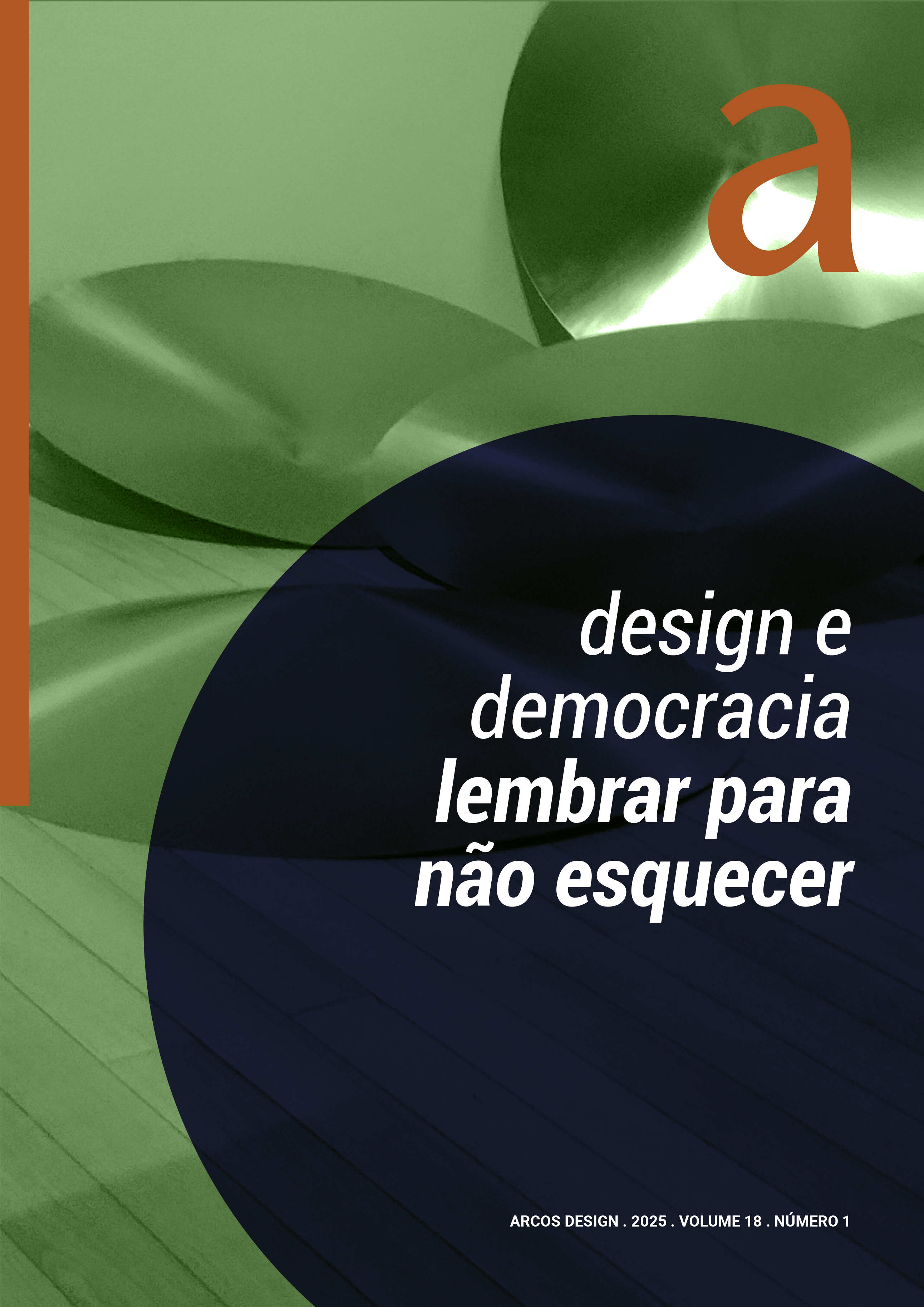Design no espaço digital
um ensaio sobre infinitudes e fricções
DOI:
https://doi.org/10.12957/arcosdesign.2025.82584Palavras-chave:
Design, Interface Digital, Seamlessness, Seamfulness, FricçãoResumo
O ensaio discute a necessidade de superar a ideia de seamlessness como virtude do design e propor abordagens que questionem a atividade projetual. Sugere-se fomentar outros padrões de design, como o humanismo projetual, que considera diferentes mentalidades e contextos de usuários. São apresentados estudos de caso que exemplificam intervenções seamful em seamlessness e vice-versa. O ensaio ressalta a importância de equilibrar as abordagens, ambas estudadas primeiramente de formas separadas, e propõe reflexões críticas sobre o papel do design no mundo.Downloads
Referências
BELL, Genevieve, DOURISH, Paul. Yesterday's tomorrows: notes on ubiquitous computing's dominant vision. Personal and Ubiquitous Computing 11, 2007.
BONSIEPE, Gui. Design, Cultura e Sociedade. São Paulo, Blucher, 2011.
BONSIEPE, Gui. Do material ao digital. São Paulo, Blucher, 2015.
CHALMERS, Matthew. Seamful Design and Ubicomp Infrastructure. Computing Sscience, University of Glasgow, Glasgow, UK, 2003.
COVID-19 pandemic triggers 25% increase in prevalence of anxiety and depression worldwide, 2022. Disponível em: www.who.int/news/item/02-03-2022-covid-19-pandemic-triggers-25-increase-in-prevalence-of-anxiety-and-depression-worldwide.
COX, Anna L. GOULD, Sandy J.J. CECCHINATO, Marta E. IACOVIDES, Ioanna. RENFREE, Ian. Design Frictions for Mindful Interactions: The Case for Microboundaries. Proceedings of the 2016 CHI Conference Extended Abstracts on Human Factors in Computing Systems, 2016.
DORN, Brandon. Web Brutalism, Seamfulness and Notion. 2020. Disponível em: www.viget.com/articles/web-brutalism-seamfulness-and-notion
ELLISON, Chappell. There’s Too Much Damn Content, and Slick UX Design Is Making it Worse. AIGA Eye on Design. 2019. Disponível em: www.eyeondesign.aiga.org/theres-too-much-damn-content-and-slick-ux-design-is-making-it-worse/
GIBSON, James J. The Ecological Approach to Visual Perception. Boston: Houghton Mifflin, 1979.
HOSSEINZADEH P, ZAREIPOUR M, BALJANI E, MORADALI MR. Social Consequences of the COVID-19 Pandemic. A Systematic Review. Investigacion y Educacion en Enfermeria, 2022.
Impacts of the COVID-19 pandemic on the social sphere and lessons for crisis management: a literature review. Natural Hazards, 2023.
INMAN, Sarah Catherine. RIBES, David. Beautiful seams: strategic revelations and concealments. Proceedings of the 2019 CHI Conference on Human Factors in Computing Systems. Glasgow, Scotland UK, 2019.
KRISHNASWAMY, Manya. Seamless or seamful design: how microboundaries and design frictions can be valuable. Cultivating Mindful Digital Practices, 2017. Disponível em: www.medium.com/learn-reflect-make/seamful-and-mindful-vs-seamless-and-mindless-interactions-39f285d9033c
Lei Geral de Proteção de Dados (LGPD): Guia de Boas Práticas para Implementação na Administração Pública Federal, 2020.
NORMAN, D. A. The Design of Everyday Things. New York: Basic Books, 2013.
Oxford English Dictionary. Oxford University Press. Oxford, England, 1983.
STAR, Susan Leigh. The Ethnography of Infrastructure. American Behavioral Scientist 43, 1999.
WEISER, Mark. The computer for the 21st century. SIGMOBILE Mob. Comput. Commun., 1999.
YELAVICH, Susan. ADAMS, Barbara, Adams. Design as Future-Making. Bloomsbury Academic, 2014.
YUAN, Jason. The desktop metaphor must die. UX Collective. 2019. Disponível em: www.uxdesign.cc/the-desktop-metaphor-must-die-676fbb34afdb
YUAN, Jason. The fallacy of easy. UX Collective. 2019. Disponível em: https://uxdesign.cc/the-fallacy-of-easy-a89ef864759b
Downloads
Publicado
Como Citar
Edição
Seção
Licença
Copyright (c) 2024 Guilherme Lopes Silva, Tiago Barros Pontes e Silva

Este trabalho está licenciado sob uma licença Creative Commons Attribution-NonCommercial-ShareAlike 4.0 International License.
Autores que publicam nesta revista concordam com os seguintes termos:
- Os Direitos Autorais dos artigos publicados na revista Arcos Design pertencem ao(s) seu(s) respectivo(s) autor(es), com os direitos de primeira publicação cedidos à Arcos Design com o trabalho simultaneamente licenciado sob uma Licença Creative Commons CC BY-NC-SA 4.0, a qual permite o compartilhamento do trabalho com reconhecimento da autoria e publicação inicial nesta revista. Para mais informações ver: https://creativecommons.org/licenses/by-nc-sa/4.0/
- O(s) autor(es) tem/têm autorização para assumir contratos adicionais separadamente, para distribuição não-exclusiva da versão do trabalho publicada nesta revista (ex.: publicar em repositório institucional ou como capítulo de livro), com reconhecimento de
autoria e publicação inicial nesta revista. - Autores têm permissão e são estimulados a publicar e distribuir seu trabalho online (ex.: em repositórios institucionais ou na sua página pessoal) a qualquer ponto antes ou durante o processo editorial, já que isso pode gerar alterações produtivas, bem como aumentar o impacto e a citação do trabalho publicado.


